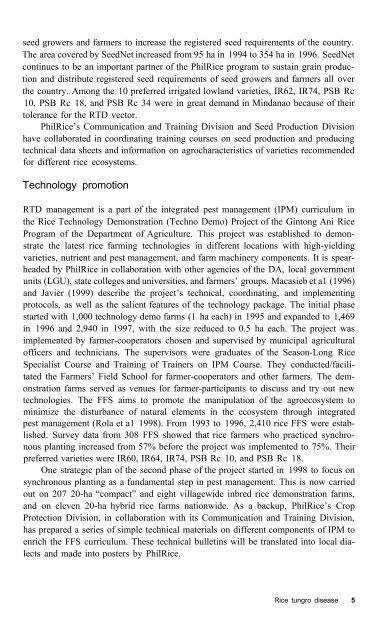Rice tungro disease management - IRRI books - International Rice ...
Rice tungro disease management - IRRI books - International Rice ...
Rice tungro disease management - IRRI books - International Rice ...
You also want an ePaper? Increase the reach of your titles
YUMPU automatically turns print PDFs into web optimized ePapers that Google loves.
seed growers and farmers to increase the registered seed requirements of the country.The area covered by SeedNet increased from 95 ha in 1994 to 354 ha in 1996. SeedNetcontinues to be an important partner of the Phil<strong>Rice</strong> program to sustain grain productionand distribute registered seed requirements of seed growers and farmers all overthe country. Among the 10 preferred irrigated lowland varieties, IR62, IR74, PSB Rc10, PSB Rc 18, and PSB Rc 34 were in great demand in Mindanao because of theirtolerance for the RTD vector.Phil<strong>Rice</strong>’s Communication and Training Division and Seed Production Divisionhave collaborated in coordinating training courses on seed production and producingtechnical data sheets and information on agrocharacteristics of varieties recommendedfor different rice ecosystems.Technology promotionRTD <strong>management</strong> is a part of the integrated pest <strong>management</strong> (IPM) curriculum inthe <strong>Rice</strong> Technology Demonstration (Techno Demo) Project of the Gintong Ani <strong>Rice</strong>Program of the Department of Agriculture. This project was established to demonstratethe latest rice farming technologies in different locations with high-yieldingvarieties, nutrient and pest <strong>management</strong>, and farm machinery components. It is spearheadedby Phil<strong>Rice</strong> in collaboration with other agencies of the DA, local governmentunits (LGU), state colleges and universities, and farmers’ groups. Macasieb et a1 (1996)and Javier (1999) describe the project’s technical, coordinating, and implementingprotocols, as well as the salient features of the technology package. The initial phasestarted with 1,000 technology demo farms (1 ha each) in 1995 and expanded to 1,469in 1996 and 2,940 in 1997, with the size reduced to 0.5 ha each. The project wasimplemented by farmer-cooperators chosen and supervised by municipal agriculturalofficers and technicians. The supervisors were graduates of the Season-Long <strong>Rice</strong>Specialist Course and Training of Trainers on IPM Course. They conducted/facilitatedthe Farmers’ Field School for farmer-cooperators and other farmers. The demonstrationfarms served as venues for farmer-participants to discuss and try out newtechnologies. The FFS aims to promote the manipulation of the agroecosystem tominimize the disturbance of natural elements in the ecosystem through integratedpest <strong>management</strong> (Rola et a1 1998). From 1993 to 1996, 2,410 rice FFS were established.Survey data from 308 FFS showed that rice farmers who practiced synchronousplanting increased from 57% before the project was implemented to 75%. Theirpreferred varieties were IR60, IR64, IR74, PSB Rc 10, and PSB Rc 18.One strategic plan of the second phase of the project started in 1998 to focus onsynchronous planting as a fundamental step in pest <strong>management</strong>. This is now carriedout on 207 20-ha “compact” and eight villagewide inbred rice demonstration farms,and on eleven 20-ha hybrid rice farms nationwide. As a backup, Phil<strong>Rice</strong>’s CropProtection Division, in collaboration with its Communication and Training Division,has prepared a series of simple technical materials on different components of IPM toenrich the FFS curriculum. These technical bulletins will be translated into local dialectsand made into posters by Phil<strong>Rice</strong>.<strong>Rice</strong> <strong>tungro</strong> <strong>disease</strong> 5
















